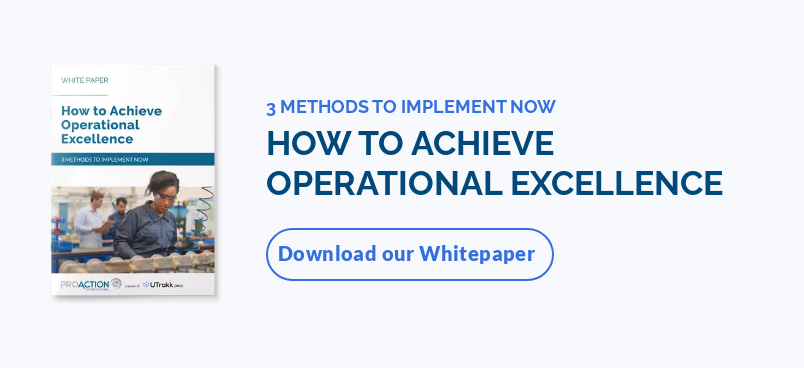What is Lean Daily Management (LDM)?
The Lean methodology has come a long way from Japan. Developed after the Second World War as part of the Toyota Production System (TPS), it focuses on eliminating waste and continuous improvement and is now considered a benchmark for organizations seeking to maximize added value while minimizing resource requirements.
So what is Lean Daily Management? It's a specific, operational application of Lean principles to day-to-day operations. Rather than letting everyone do things their own way, this system provides a structured framework for companies to monitor and continuously improve operational process performance day after day.
Lean Daily Management principles
- Transparency: All relevant process and performance information must be visible and accessible to all levels of the organization. Employees can quickly detect problems and identify improvement opportunities using visual management tools.
- Employee empowerment: It is essential for all employees, from the operational level through middle management to top management, to be actively involved. Everyone is responsible for identifying problems, proposing solutions, and participating fully in continuous improvement. Through collective accountability, everyone contributes to the organization's overall performance.
- Continuous improvement: Continuous improvement, or Kaizen, is based on the conviction that even minor daily improvements can lead to significant long-term performance improvement. Employees are encouraged to propose ideas for optimizing processes, making the organization more agile and competitive.
- Strategic alignment: Daily activities are directly aligned with the company's strategic objectives. Every action, meeting, and decision is taken in the context of the organization's long-term priorities. This alignment ensures that team efforts support the overall strategic direction, creating consistency in executing objectives.
Key practices of Lean Daily Management
Leader Standard Work
Leader Standard Work defines the specific tasks and responsibilities of managers at each level of the organization, including regular activities such as :
- Gemba Walks: Floor tours to observe processes first-hand, understand operators' challenges, and immediately identify opportunities for improvement.
- Process confirmation: Regular checks conducted by team leaders to ensure that operational processes are consistently executed as planned and remain aligned with defined standards.
- Daily meetings: Short team meetings to review the previous day's performance, identify problems, and coordinate corrective action.
- Visual management: Method using visual tools (visual display board, KPIs, color code, etc.) to make information visible to all, to streamline communication, and to better manage work practices.
Example
Every morning, the production manager carries out a series of standardized checks. He starts his day by reviewing the previous day's performance metrics on a visual dashboard set up on the shop floor. During one of these checks, he notices that the defect rate has risen slightly on a specific line. Thanks to this routine, he immediately organizes a meeting with the team concerned to understand the origin of the problem and proposes targeted training to prevent it from happening again.
Tiered management
This approach distributes responsibilities across different hierarchical levels of the organization. Each level participates in a daily accountability process, ensuring tasks are completed, and problems are addressed promptly at the appropriate level. This system guarantees that issues are effectively managed, with an escalation process in place for those requiring action at a higher level.
Tiered management also helps to maintain fluid communication and ensure that day-to-day actions are well aligned with strategic objectives.
Example
A quality problem is detected on a production line. The supervisor tries to resolve the anomaly by modifying certain parameters, but the problem persists.
Thanks to step-by-step management, he passes on the information to the production manager, who calls in a team of experts to analyze the situation in greater depth.
Kaizen
Kaizen integrates continuous improvement into the plant's daily routines. For example, problems identified during Gemba Walks or daily meetings can lead to continuous improvement methods to refine processes. These methods ensure that the organization remains agile, responsive, and constantly optimizing.
Example
During a Kaizen session, the operators of a production line suggested modifying the assembly sequence of a component to reduce cycle time. After a few tests, the new method saved 15 seconds per unit. This time savings, applied to thousands of parts produced every month, translates into significant savings and greater customer satisfaction.
Problem-solving tools
Problem-solving tools such as PDCA, 5 Whys, QRQC, and cause-and-effect diagrams are necessary to quickly identify, analyze, and resolve problems that arise in day-to-day operations. They help maintain continuous improvement by making it easier to detect deviations from standards and implement effective solutions.
Example
When a recurring defect is found in a series of products, a multi-disciplinary team uses the 5 Whys method to identify the root cause. They discover the problem is due to incorrect machine settings after each maintenance. By revising the maintenance protocol, the team eliminates the cause of the defect, improving product quality and reducing customer returns.
Benefits of Lean Daily Management
Reduce unplanned production downtime
Thanks to Gemba Walks and continuous process monitoring, anomalies or failures are quickly detected and corrected. As a result, there is less unplanned downtime, leading to better continuity of operations, a more stable production flow, and maintaining or even increasing production speed.
Optimized use of resources
Daily Lean Management enables real-time monitoring of resource utilization. By immediately adjusting processes in line with daily observations, plants can reduce raw material wastage and optimize team allocation in relation to requirements.
Anticipation rather than reaction
Lean Daily Management encourages proactive reactivity by identifying potential problems before they become critical. Rather than acting in firefighting mode, teams anticipate challenges and plan preventive interventions. As a result, the plant becomes more flexible, adapting to change without compromising quality or productivity.
Enhanced coordination between teams
By promoting transparency and communication across management levels, Lean day-to-day management facilitates coordination between different teams (production, maintenance, quality). This reduces organizational silos, ensures greater cohesion in implementing action plans, and speeds up decision-making.
Employee engagement and empowerment
With Lean day-to-day management, employees are empowered as they play an active role in detecting and resolving problems. This direct involvement increases motivation and the sense of contribution to the plant's success, with workers who want to stay with the company and perform better.
Aligning strategic objectives with day-to-day operations
Thanks to structured processes such as visual and tiered management, Lean Daily Management ensures that the plant's strategic objectives are translated into concrete daily actions. Every operational decision supports the company's overall priorities.
Improving workplace safety
Constant attention to daily processes also includes rigorous monitoring of safety practices. By including safety in daily routines, Lean Daily Management reduces the risk of accidents, improves working conditions, and ensures compliance with current standards.
8 Steps to implement a Lean Daily Management system in your plant

1. Assess your current situation
The first step is to understand where your organization stands about Lean principles. This includes auditing existing processes and identifying waste, bottlenecks, and areas for improvement.
It's essential to map the critical processes directly influencing your production performance.
Actions to implement:
- Map the value chain to identify waste.
- Gather data on current performance (Overall Equipment Effectiveness, quality, cycle time, defect rate, etc.).
- Involve operational teams to gather feedback on current difficulties.
2. Set clear objectives
Once the current state has been assessed, it's time to set operational objectives for implementing day-to-day Lean Management. These objectives must be in line with the plant's overall strategy. They may include reductions in downtime, quality improvements, or productivity increases, for example.
Actions to implement:
- Set objectives based on the results of the initial assessment.
- Communicate these objectives to all levels of the organization to ensure full alignment.
- Choose relevant Lean key performance metrics to monitor progress towards these objectives.
3. Define Leader Standard Work
Establish daily routines for managers. This includes how they should organize their day, the types of tasks they should complete regularly, and the interactions they should have with their teams to ensure that processes run as planned.
Actions to implement:
- Develop clear routines for leaders.
- Create guides and offer training and coaching to ensure that all leaders understand their daily responsibilities and know how to apply Lean principles in their work.
- Integrate regular reviews of these routines into the continuous improvement process to adjust them as necessary.
4. Implement key practices
This stage involves integrating Lean practices into the plant's day-to-day operations. This involves using problem-solving tools and implementing concrete processes (Gemba Walk, daily meetings, visual management, escalation processes).
The former will facilitate root cause analysis, helping to address the underlying issues rather than just treating symptoms, and the latter will support the routines established by the leader's standard work.
Actions to implement:
- Organize regular Gemba Walks to enable leaders to immerse themselves in operational processes, identify problems in real-time, and propose improvements on the spot.
- Set up short daily meetings to review the previous day's performance, quickly resolve identified problems, and plan corrective actions.
- Use manufacturing dashboards and other visual tools to make performance and variances visible to all.
- Create multi-disciplinary work teams to tackle complex problems.
- To ensure a rapid and effective response, create procedures for escalating problems that cannot be solved at the initial level.
5. Train teams
Every employee needs to understand Lean principles, how they apply to their day-to-day work, and what tools to use to identify and solve problems.
Training must be ongoing, with regular sessions to reinforce Lean skills and introduce new practices.
Actions to implement:
- Develop Lean training programs adapted to each level of the organization.
- Encourage the sharing of best practices and peer-to-peer learning.
6. Foster continuous improvement
Kaizen must be encouraged at all levels to become integral to the plant's daily culture. Over time, this consistent focus on improvement will help to establish strong Lean habits among all employees.
Actions to implement:
- Create Kaizen groups to work on specific improvement projects.
- Set up a recognition system for employees who suggest improvement ideas.
- Monitor and measure the impact of initiatives on plant performance.
7. Leverage UTrakk Daily Management System
To strengthen the effectiveness of Lean Daily Management, using digital technologies like UTrakk provides increased visibility on operational processes, speeds up problem-solving, and facilitates communication between teams.
Our Daily Management System (DMS) lets you set up Leader Standard Work in a digital agenda, standardize daily management routines such as meetings and floor tours, implement improvement actions and projects, and track KPIs in real time, for elevated operational performance.
By centralizing these key management activities, UTrakk ensures alignment and fosters engagement across all levels of the organization.

Actions to implement:
- Integrate UTrakk DMS into your environment to implement and structure Lean Daily Management.
- Use our daily management system’s features to monitor and improve the performance of Lean operations and teams.
- Train teams to use the solution.
8. Measure and adjust
Once day-to-day Lean Management is in place, measuring progress against targets is vital. KPIs will enable us to assess the effectiveness of Lean initiatives and adjust processes according to the results obtained.
Actions to implement:
- Organize regular performance reviews to assess results against objectives.
- Involve teams in data analysis to identify areas for improvement.
- Adjust Lean strategies according to feedback and data collected.
Sustaining success with Lean Daily Management and UTrakk
Adopting Lean Daily Management means committing to a rigorous process that structures each day around clear objectives and meticulous execution. This methodology does more than simply improve short-term performance indicators; it makes Kaizen part of the organization's DNA, making every team member a key player in its success.
Based on proven practices, Lean Daily Management transforms plant processes into an agile and resilient ecosystem capable of adapting rapidly to market changes.
When this approach is reinforced by a tool like the UTrakk DMS, the entire organization gains depth and responsiveness. Providing real-time visibility on operations and key performance indicators, the solution enables you to capitalize on every action taken, track improvements precisely, and anticipate future plant needs.
This synergy between daily Lean Management and UTrakk leads to sustained operational excellence, where every day is a new opportunity to perfect the whole organization.









